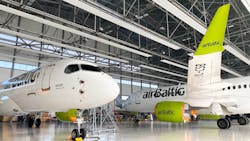airBaltic has Performed Seven Airbus A220-300 C Checks
Latvian airline airBaltic has successfully continued its maintenance program, completing C check on the first seven of its Airbus A220-300 aircraft, and planning to do four more C checks soon. In 2019, airBaltic became the first airline entitled to provide a full scope of maintenance for Airbus A220-300 aircraft type.
Andris Vaivads, SVP Technical Operations of airBaltic said, “With each C check, our Airbus A220-300 aircraft also receive a number of additional modifications, further improving efficiency and reliability of the most aircraft. As a carrier operating only the A220-300, we are also unique in being able to perform full scope of maintenance on the aircraft type.”
A C check is a part of the aircraft maintenance program that has to be performed on all commercial aircraft after a certain time of usage. For Airbus A220-300, the manufacturer has defined that a C check has to be performed every 8,500 flight hours. Overall, 40 people work on a single C check. airBaltic currently employs more than 120 technicians.
Since May, airBaltic operates all of its flights with a single aircraft type – Airbus A220-300, thus minimizing the complexity and benefiting from the additional efficiency provided by the aircraft.
Since introduction of the Airbus A220-300 aircraft in late 2016, airBaltic has carried over 5,600,000 passengers on the aircraft. Thus far, most passengers have been carried to such destinations as Amsterdam, Paris, London and Moscow. Airbus A220-300’s have completed close to 60,000 flights and flown over 141,000 block hours.
The Airbus A220-300 has performed beyond the company’s expectations, delivering better overall performance, fuel efficiency and convenience for both passengers and the staff. This aircraft offers an excellent flying experience with such benefits for passengers as wider seats, larger windows, more hand luggage space in the cabin, improved lavatories and much more.
The Airbus A220-300 has a high-quality air filtering system equipped with High Efficiency Particulate Air (HEPA) type filter that provides the best level of filtration currently available for recirculated cabin air from the very beginning of boarding, during entire flight and until all passengers have left the aircraft. The quality of cabin air is carefully controlled and is recirculated with ventilation rates that provide a total change of air 20-30 times per hour.
In addition, the new aircraft is also considerably quieter – with a four times smaller noise footprint. Moreover, at the moment it is the greenest commercial aircraft in the world, as it is the first aircraft to have a transparent declaration of the life-cycle environmental impact, helping to reduce CO2 and NOX emissions by 20 percent and 50 percent respectively.



